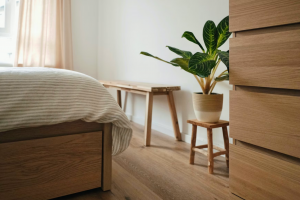Hardwood flooring is a timeless and elegant addition to any home, but it can also be a significant financial investment. However, there are ways to incorporate hardwood into your home without breaking the bank.
One solution is to choose engineered hardwood over solid hardwood. And there are also lots of other ways to save money we will discuss further down in today’s blog post!
What Is Engineered Hardwood?
Engineered hardwood is a type of flooring that consists of a top layer of real hardwood, called the wear layer, and multiple layers of plywood or high-density fiberboard underneath.
This construction provides the same natural look and feel of solid hardwood, but at a more affordable cost. Additionally, engineered hardwood is more stable and durable than solid hardwood, making it a great choice for high-moisture areas such as bathrooms and kitchens.
Advantages of Engineered Hardwood
One of the main advantages of engineered hardwood is that it is more stable and durable than solid hardwood. Because it is made of multiple layers, it is less likely to expand or contract due to changes in humidity or temperature. This makes it a great option for homes with fluctuating humidity levels or for areas of the home that receive a lot of foot traffic.
Another advantage of engineered hardwood is that it is more affordable than solid hardwood. Because it is made of multiple layers, it can be produced more efficiently and at a lower cost. This makes it a great option for homeowners who want the look and feel of hardwood without the expense.
How To Incorporate Hardwood Into Specific Areas of Your Home

[Source: Unsplash]
Living Room
The living room is often the focal point of the home, and hardwood flooring can add a touch of elegance and warmth to the space. Consider installing engineered hardwood in the living room to create a cohesive look and feel throughout the home.
Bedroom
Hardwood flooring in the bedroom can create a cozy and comfortable atmosphere. And, it’s a great option for those who suffer from allergies as it does not accumulate dust and other allergens as easily as carpet does.
Kitchen
Engineered hardwood is a great option for the kitchen as it is resistant to moisture and heat. Its durability makes it perfect for high-traffic areas and can withstand spills and drops.
How To Maintain Engineered Hardwood
One of the main benefits of engineered hardwood is that it is easy to maintain. The top layer of real hardwood can be easily cleaned and protected with regular sweeping and mopping.
It is also important to use the appropriate cleaning products for hardwood flooring, such as pH-neutral cleaners that will not damage the finish of the floor. The MacDonalds Hardwoods Easy Floor Cleaner is recommended for these reasons.
How to Shop for the Best Deals on Engineered Hardwood

[Source: Unsplash]
- Compare prices: When shopping for engineered hardwood, it’s important to compare prices from different retailers. This will give you an idea of the typical cost and help you identify any particularly good deals.
- Check for sales and discounts: Many retailers offer sales and discounts on engineered hardwood at various times throughout the year. Keep an eye out for these deals and try to plan your purchase accordingly.
- Consider purchasing flooring remnants: Flooring remnants are smaller pieces of flooring that are left over from larger projects. These can often be purchased at a significant discount. However, be aware that the available sizes and quantities may be limited and that you may need to get creative with how you use the pieces.
- Look for alternative wood species: Some wood species are less expensive than others. Consider choosing an alternative wood species that has a similar look and feel to your desired species but at a lower cost.
DIY Installation Tips
- Measure the space: Before buying any flooring, measure the space you plan to install it in. This will give you an idea of how much flooring you need and help you avoid buying too much or too little.
- Prepare the subfloor: Make sure the subfloor is clean, level, and free of any debris. This will ensure a smooth and even installation.
Watch tutorials and read instructions: Before installing engineered hardwood, watch tutorials and read instructions to familiarize yourself with the process and make sure you have all the necessary tools and materials.
- Take your time: Installation can be time-consuming, so make sure to set aside enough time to do it properly. Rushing the process can lead to mistakes and ultimately cost more in the long run.
Bonus Tips to Save Money

[Source: Unsplash]
- Choose a lower-grade wear layer: While a higher-grade wear layer will provide a more uniform and consistent appearance, a lower-grade wear layer will still offer the same durability and stability at a lower cost.
- Look for alternative wood species: Some wood species are less expensive than others. Consider choosing an alternative wood species that has a similar look and feel to your desired species but at a lower cost.
- Purchase in bulk: If you’re planning on installing hardwood in multiple rooms, consider purchasing a bulk amount to save on cost per square foot.
- Shop during off-peak seasons to take advantage of discounted prices.
Look for flooring that’s on clearance or overstock.
- Keep in mind that engineered hardwood is a cost-effective option than solid hardwood, so it’s a great option to consider if you’re trying to save money.
Conclusion
Incorporating hardwood into your home doesn’t have to break the bank. Engineered hardwood is a cost-effective option that offers the same natural look and feel of solid hardwood, but at a more affordable cost.
By choosing a lower-grade wear layer, shopping for the best deals, and incorporating it into specific areas of your home, you can save even more money among other tips we outlined. At MacDonald Hardwoods, we offer a wide variety of engineered hardwood options to fit any budget and style.
Contact us today to learn more about how we can help you incorporate hardwood into your home without breaking the bank!